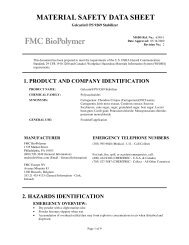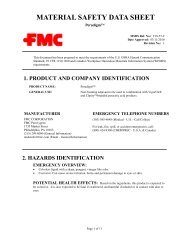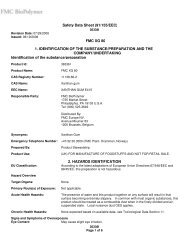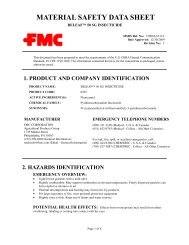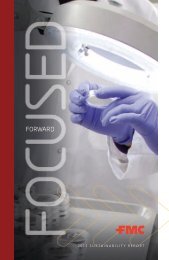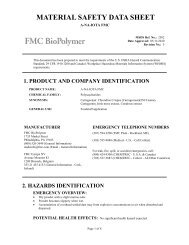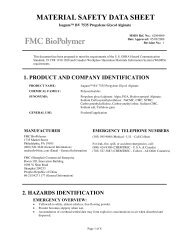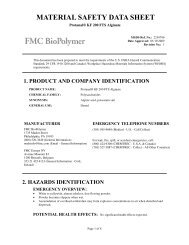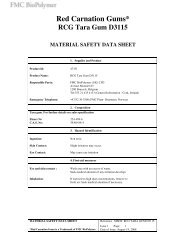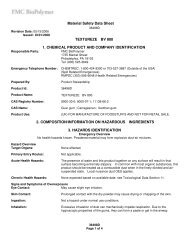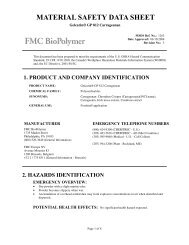Chairman's - FMC Corporation
Chairman's - FMC Corporation
Chairman's - FMC Corporation
Create successful ePaper yourself
Turn your PDF publications into a flip-book with our unique Google optimized e-Paper software.
value exceeds the estimated fair value of assets, which is based on discounted cash flows at the lowest level<br />
determinable. The estimated cash flows reflect our assumptions about selling prices, volumes, costs and market<br />
conditions over a reasonable period of time.<br />
We perform an annual impairment test of goodwill in the third quarter. The assumptions used to estimate<br />
fair value include our best estimate of future growth rates, discount rates and market conditions over a reasonable<br />
period. We performed this test in 2009 and determined that no impairment charge was required.<br />
Pensions and other postretirement benefits<br />
We provide qualified and nonqualified defined benefit and defined contribution pension plans, as well as<br />
postretirement health care and life insurance benefit plans to our employees. The costs (benefits) and obligations<br />
related to these benefits reflect key assumptions related to general economic conditions, including interest<br />
(discount) rates, healthcare cost trend rates, expected rates of return on plan assets and the rates of compensation<br />
increases for employees. The costs (benefits) and obligations for these benefit programs are also affected by<br />
other assumptions, such as average retirement age, mortality, employee turnover, and plan participation. To the<br />
extent our plans’ actual experience, as influenced by changing economic and financial market conditions or by<br />
changes to our own plans’ demographics, differs from these assumptions, the costs and obligations for providing<br />
these benefits, as well as the plans’ funding requirements, could increase or decrease. When actual results differ<br />
from our assumptions, the difference is typically recognized over future periods. In addition, the unrealized gains<br />
and losses related to our pension and postretirement benefit obligations may also affect periodic benefit costs<br />
(benefits) in future periods.<br />
We use certain calculated values of assets under methods both to estimate the expected rate of return on<br />
assets component of pension cost and to calculate our plans’ funding requirements. The expected rate of return<br />
on plan assets is based on a market-related value of assets that recognizes investment gains and losses over a<br />
five-year period. We use an actuarial value of assets to determine our plans’ funding requirements. The actuarial<br />
value of assets must be within a certain range, high or low, of the actual market value of assets, and is adjusted<br />
accordingly.<br />
We select the discount rate used to calculate pension and other postretirement obligations based on a review<br />
of available yields on high-quality corporate bonds, including Moody’s Investors Service, Inc. (“Moody’s”)<br />
Aa-rated Corporate and Industrial bond indices. In selecting the discount rate for 2009, we placed particular<br />
emphasis on a yield-curve approach designed by our actuary to derive an appropriate discount rate for computing<br />
the present value of the future cash flows associated with our pension and other postretirement obligations taking<br />
into consideration both the timing and amount of the cash flows. The specific interest rates supporting the yield<br />
curve were derived from calculated returns (yields) from a portfolio of high-quality (Aa-graded or higher) bond<br />
investments constructed by our actuary.<br />
In developing the assumption for the long-term rate of return on assets for our U.S. Plan, we take into<br />
consideration the technical analysis performed by our outside actuaries, including historical market returns,<br />
information on the assumption for long-term real returns by asset class, inflation assumptions, and expectations<br />
for standard deviation related to these best estimates. We also consider the historical performance of our own<br />
plan’s trust, which has earned a compound annual rate of return of approximately 9.71 percent over the last 20<br />
years (which is in excess of comparable market indices for the same period) as well as other factors which are<br />
discussed in Note 13 to our consolidated financial statements in this Form 10-K. For the sensitivity of our<br />
pension costs to incremental changes in assumptions see our discussion below.<br />
50



